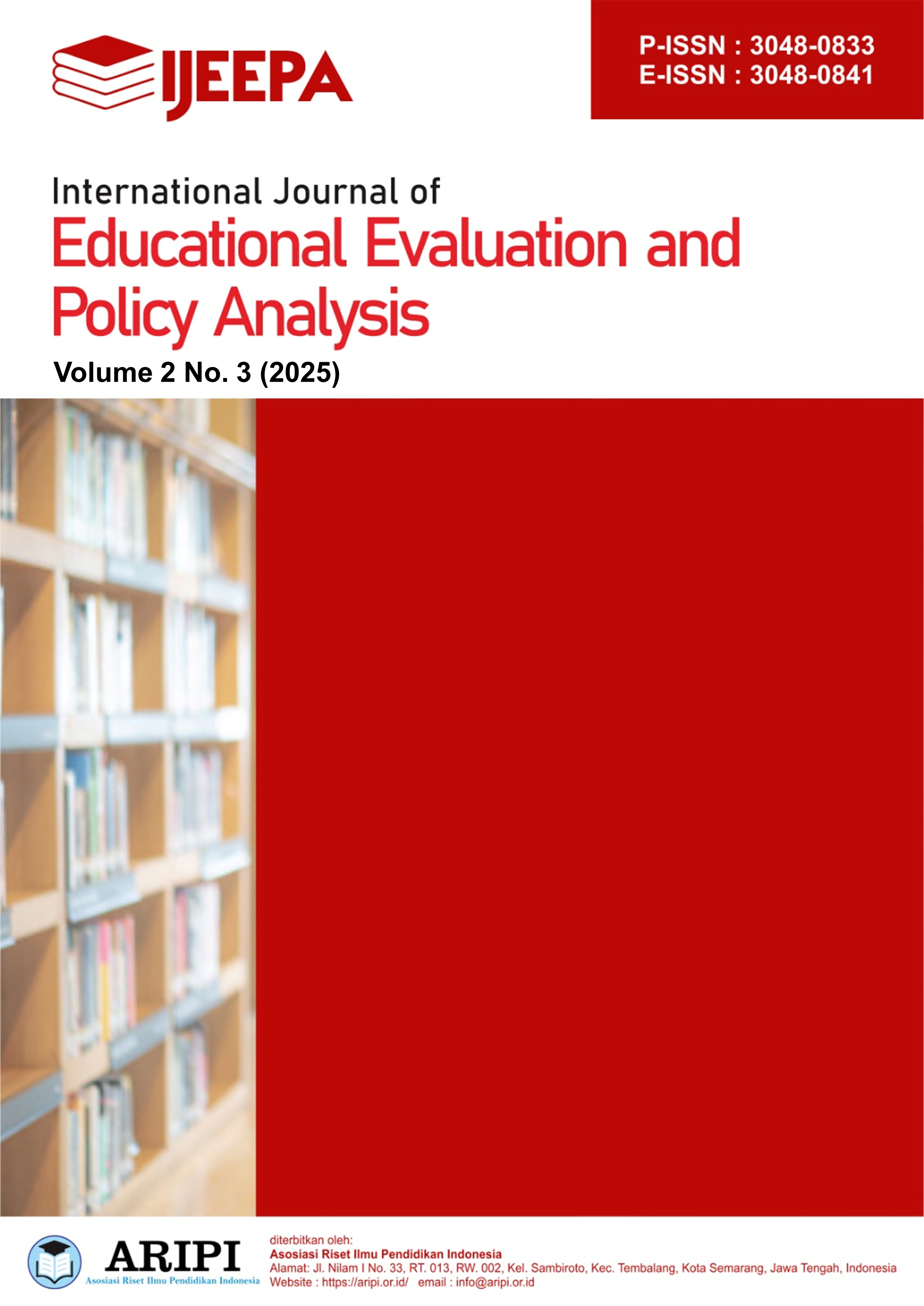A Differentiated Instruction Implementation in EFL Second-ary School
(Case Study: SMA Islam Plus Adzkia)
DOI:
https://doi.org/10.62951/ijeepa.v2i3.374Keywords:
Differentiated Learning, EFL Teaching, Learning Strategies, Instructional Methods, Student EngagementAbstract
The topic of Differentiated Instruction (DI) has recently been studied by researchers and practitioners due to its importance and potential to improve student learning. In this regard, the current study aims to provide a concise overview of DI in the context of EFL to illustrate the need for its implementation in the classroom to foster successful language learning. Since differentiated instruction is designed to place students at the centre of the teaching and learning process, promote equity and academic success, as well as recognize diversity among students, it enables teachers to address a student’s unique needs, interests, abilities, English proficiency, and preferred learning strategies. While challenges such as increased workload and implementation pressure in DI may arise, the potential benefits of this approach to students' learning processes, attitudes toward learning, and long-term success are notable. Therefore, the learning process is maximized when teachers are committed to differentiated instruction. SMA ISLAM PLUS ADZKIA (SIPA) is one of the most popular spotlight of school in Medan which the school was succeed in graduating their Alumni to Kedinasan and private university both inside and outside the country with scholarship. This school becomes the spot or role model for many other schools in Medan, therefore, the researcher intended to investigate further about the teaching model applied in this school, especially in EFL classroom in studying English. Some problems need to be answered after applying this study, such as how the English teachers manage the class to apply the DI, how is the students’ understanding about the subject after they applied DI
References
N. and E. Sulindra, "Speaking accuracy, fluency, and beyond Indonesian vocational students' voices," LLT Journal: Journal on Language and Language Teaching, vol. 25, no. 2, pp. 379–394, 2022. [Online]. Available: https://doi.org/10.24071/llt.v25i2.4579
G. S. Abramova and V. S. Mashoshina, "On differentiation strategies in the EFL mixed-ability classroom: Towards promoting the synergistic learning environment," European Journal of Contemporary Education, vol. 10, no. 3, pp. 558–573, 2021. [Online]. Available: https://doi.org/10.13187/ejced.2021.3.558
R. Adawiyah, "The effectiveness of content-based Instruction in teaching speaking skills for EFL learners," VELES Voices of English Language Education Society, vol. 2, no. 2, pp. 105–112, 2018. [Online]. Available: https://doi.org/10.29408/veles.v2i2.846
R. P. Adhikary, "An analysis of the challenges and strategies of English Language Teachers in teaching mixed-ability classes: A qualitative inquiry," Revista Multi-Ensayos, vol. 9, no. 18, pp. 3–20, 2023. [Online]. Available: https://doi.org/10.5377/multiensayos.v9i18.16427
F. Al-Shammakhi and S. Al-Humaidi, "Challenges facing EFL teachers in mixed ability classes and strategies used to overcome them," World Journal of English Language, vol. 5, no. 3, 2015. [Online]. Available: https://doi.org/10.5430/wjel.v5n3p33
M. S. Al-Subaiei, "Challenges in mixed ability classes and strategies ELI teachers utilize to cope with them," English Language Teaching, vol. 10, no. 6, pp. 182, 2017. [Online]. Available: https://doi.org/10.5539/elt.v10n6p182
R. S. Arianto, J. Juhana, and R. Ruminda, "Building students’ confidence in speaking English through Differentiated Instruction," Lectura: Jurnal Pendidikan, vol. 14, no. 2, pp. 276–287, 2023. [Online]. Available: https://doi.org/10.31849/lectura.v14i2.14806
A. Burns, Doing action research in English language teaching: A guide for practitioners. Routledge, 2010. [Online]. Available: http://e-journal.hamzanwadi.ac.id/index.php/veles/index
S. Celik, "Can Differentiated Instruction create an inclusive classroom with diverse learners in an elementary school?," Journal of Education and Practice, vol. 10, no. 6, pp. 31–40, 2019. [Online]. Available: https://doi.org/10.7176/JEP/10-6-05
H. Dack, E. Chiles, L. Kathman, A. Poessnecker, and E. Strohl, "The key to equitable differentiation," Middle School Journal, vol. 53, no. 5, pp. 15–32, 2022. [Online]. Available: https://doi.org/10.1080/00940771.2022.2119756
M. R. Devi, "The importance of speaking and listening abilities for EFL students," International Journal of Advanced Multidisciplinary Scientific Research, 2022. [Online]. Available: https://doi.org/10.31426/ijamsr.2022.5.7.5511
A. Dincer, "EFL learners’ beliefs about speaking English and being a good speaker: A metaphor analysis," Universal Journal of Educational Research, vol. 5, no. 1, pp. 104–112, 2017. [Online]. Available: https://doi.org/10.13189/ujer.2017.050113
S. Gangi, "Differentiation instruction using multiple intelligences in the elementary school classroom: A literature review," University of Wisconsin-Stout, 2011.
Y. Girma, "A study on the effectiveness of differentiated instructional approach in promoting English grammar learning achievement on high school EFL students, Addis Ababa, Ethiopia," Revista EDUCARE, vol. 26, no. 3, pp. 30–46, 2022. [Online]. Available: https://doi.org/10.46498/reduipb.v26i3.1799
S. Kemmis, R. McTaggart, and R. Nixon, The action research planner. Springer, 2014.
M. M. Kotob and M. Ali Abadi, "The influence of differentiated Instruction on students' academic achievement in mixed ability classrooms," International Linguistics Research, vol. 2, no. 2, pp. 8–28, 2019. [Online]. Available: https://doi.org/10.30560/ilr.v2n2p8
E. R. Lai, "Collaboration: A research report," Pearson Education Research Report, 2011.
T. Q. Lap and H. V. U. Thy, "EFL teachers’ challenges in maximizing classroom interaction," Studies in English Language Teaching, vol. 5, no. 4, pp. 695, 2017. [Online]. Available: https://doi.org/10.22158/selt.v5n4p695
D. Luspa, "Mixed ability classes in EFL learning: Problems and solutions," Esteem, vol. 1, no. 1, 2018. [Online]. Available: https://doi.org/10.31851/esteem.v1i1.4826
Magableh and A. Abdullah, "On the effectiveness of differentiated Instruction in enhancing Jordanian students' overall achievement," International Journal of Instruction, vol. 13, no. 2, pp. 533–548, 2020. [Online]. Available: https://doi.org/10.29333/iji.2020.13237a
Magableh and A. Abdullah, "The effect of Differentiated Instruction on EFL learners: Teachers’ perspective," International Journal of Academic Research in Business and Social Sciences, vol. 10, no. 5, pp. 686–641, 2020. [Online]. Available: https://doi.org/10.6007/IJARBSS/v10-i5/7235
M. Mardhatillah and S. Suharyadi, "Differentiated Instruction: Challenges and opportunities in EFL classroom," Journal of English Language Teaching and Linguistics, vol. 8, no. 1, pp. 69, 2023. [Online]. Available: https://doi.org/10.21462/jeltl.v8i1.1022
A. A. Mehany, "Differentiated Instruction to develop Al-Azhar students' writing fluency," International Research Journal of Science, vol. 2, no. 1, pp. 26, 2022. [Online]. Available: https://doi.org/10.5281/zenodo.6496744
E. Meşe and E. Mede, "Using digital differentiation to improve EFL achievement and self-regulation of tertiary learners: the Turkish context," Innovation in Language Learning and Teaching, vol. 17, no. 2, pp. 340–353, 2023. [Online]. Available: https://doi.org/10.1080/17501229.2022.2043872
L. Naka, "Differentiated Instruction is the main tool for EFL learning enhancement," International Journal of Sciences: Basic and Applied Research (IJSBAR), vol. 42, no. 2, pp. 106–112, 2018. [Online]. Available: http://gssrr.org/index.php?journal=JournalOfBasicAndApplied
D. Neuvirthova and Z. Gadušová, "Differentiated instruction strategies in EFL classroom: A case study," EDULEARN Proceedings, 2021. [Online]. Available: https://doi.org/10.21125/edulearn.2021.1624
Pallant, SPSS survival manual: A step-by-step guide to data analysis using IBM SPSS, 6th ed. McGraw-Hill Education, 2016.
E. S. Rumkoda and M. Alinda, "Using differentiated instruction strategy to improve students' speaking skills in the tenth grade of Seminary Maria Bunda Segala Bangsa Senior High School in the academic year of 2021/2022," Edunipa Journal, vol. 3, no. 2, pp. 52–63, 2022.
M. Sapan and E. Mede, "Differentiated Instruction (DI) affects achievement, motivation, and autonomy among English learners," Iranian Journal of Language Teaching Research, vol. 10, no. 1, pp. 127–144, 2022. [Online]. Available: https://doi.org/10.30466/ijltr.2022.121125
M. Shen and T. Chiu, "EFL learners’ English speaking difficulties and strategy use," Education and Linguistics Research, vol. 5, no. 2, pp. 88, 2019. [Online]. Available: https://doi.org/10.5296/elr.v5i2.15333
X. Sun, "Differentiated Instruction in L2 teaching: Two extensive reading programs conducted during the COVID-19 pandemic," Innovation in Language Learning and Teaching, vol. 17, no. 2, pp. 177–190, 2023. [Online]. Available: https://doi.org/10.1080/17501229.2021.1979985
N. K. A. Suwastini, N. K. A. Rinawati, I. G. A. S. R. Jayantini, and G. R. Dantes, "Differentiated Instruction across EFL classrooms: A conceptual review," TELL-US Journal, vol. 7, no. 1, pp. 14–41, 2021. [Online]. Available: https://doi.org/10.22202/tus.2021.v7i1.4719
W. The, "Communicative Language Teaching (CLT) in the context of online learning: A literature review," International Journal of TESOL & Education, vol. 1, no. 2, pp. 65–71, 2021. [Online]. Available: https://i-jte.org/index.php/journal/article/view/23
Downloads
Published
Issue
Section
License
Copyright (c) 2025 International Journal of Educational Evaluation and Policy Analysis

This work is licensed under a Creative Commons Attribution-ShareAlike 4.0 International License.




